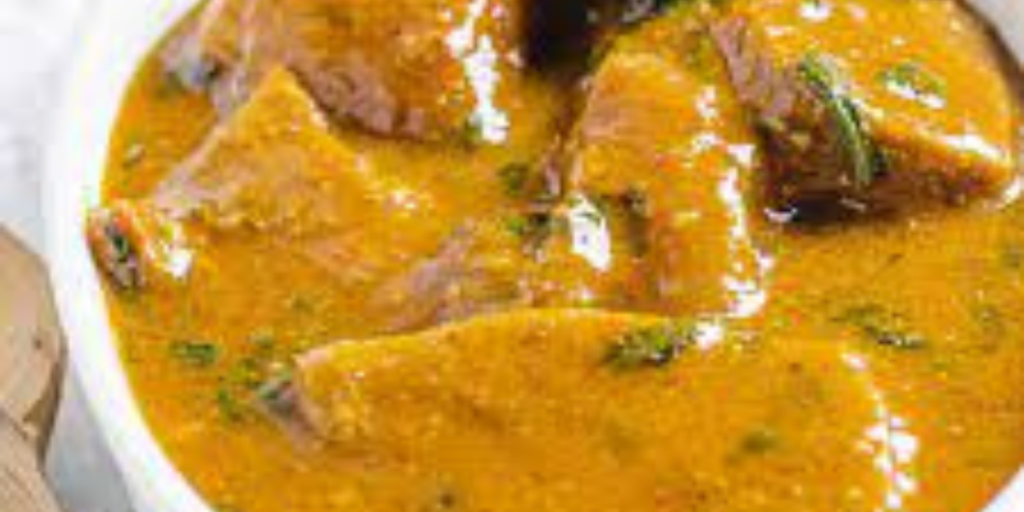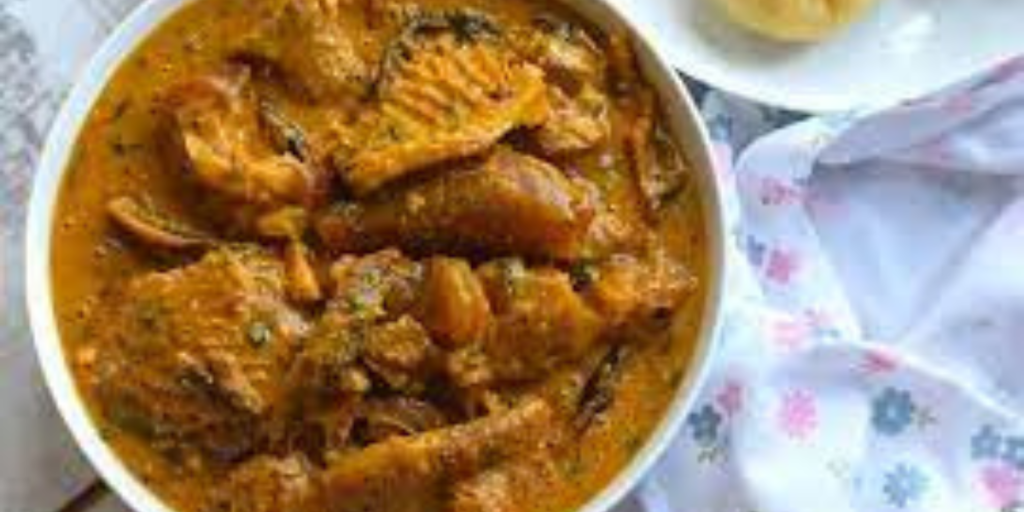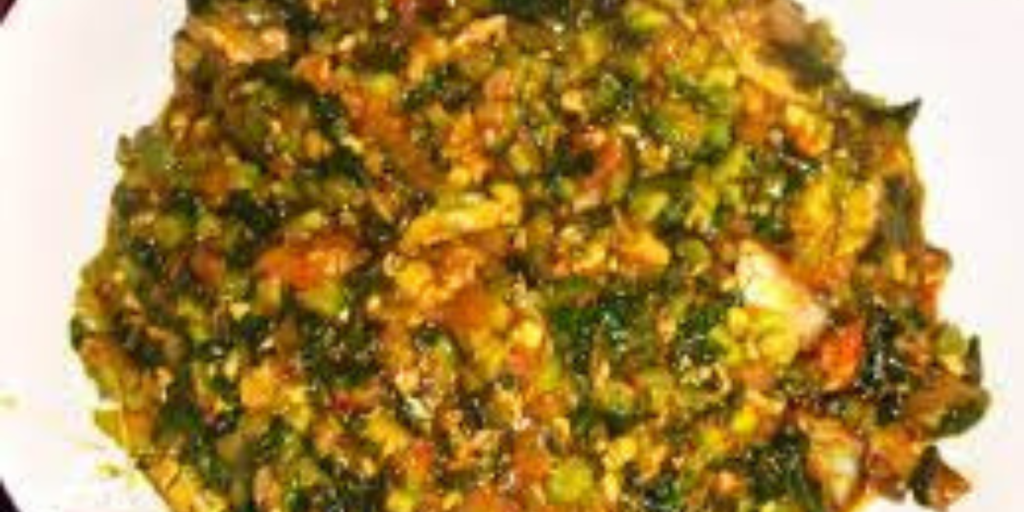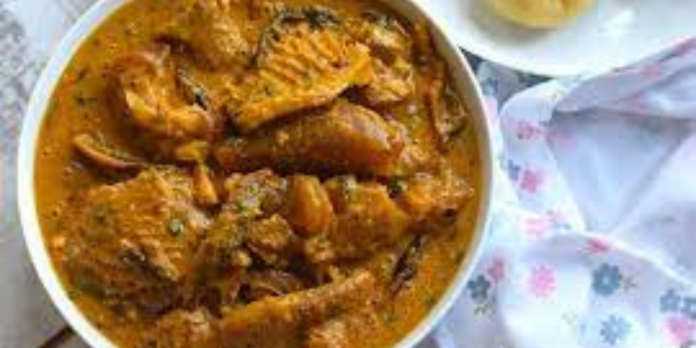Table of Contents
ogbono soup recipe : Ogbono soup is a beloved Nigerian dish known for its rich and hearty flavor. While many people add various leaves such as Uziza to enhance the flavor, this Ogbono soup recipe will show you how to make a delicious version without using Uziza. By focusing on the other essential ingredients and cooking techniques, you can still achieve a tasty and satisfying dish that will leave everyone craving more.
In this article, we’ll explore the step-by-step process of preparing Ogbono soup without Uziza, delve into the health benefits of the ingredients, and provide tips to ensure that your soup turns out perfectly every time. Whether you’re an experienced cook or trying this dish for the first time, this guide will equip you with everything you need to create a mouthwatering Ogbono soup recipe.
Best Ogbono Soup Recipe With Uziza Leaf in 2024
What is Ogbono Soup?
Ogbono soup is a traditional Nigerian dish made from ground ogbono seeds, which come from the African bush mango, scientifically known as Irvingia gabonensis. The seeds are ground into a fine powder and used as a thickener in the soup, giving it a unique, slimy texture that is characteristic of this dish.
The Ogbono soup recipe is versatile and can be prepared with various types of meat, fish, and vegetables, making it a staple in many Nigerian households. It’s often served with swallows like pounded yam, eba, or fufu, creating a satisfying meal that is both comforting and nourishing.
Ingredients for Ogbono Soup Without Uziza
To prepare this flavorful Ogbono soup recipe without Uziza, you will need the following ingredients:
- 1 cup of ground ogbono seeds
- 500g of assorted meat (beef, goat meat, or a combination)
- 200g of stockfish (optional)
- 200g of smoked fish
- 2 tablespoons of palm oil
- 1 onion, chopped
- 2 tablespoons of ground crayfish
- 2 cups of water or meat stock
- 2 tablespoons of ground pepper (to taste)
- 1-2 stock cubes (optional)
- Salt to taste
- 1 handful of spinach or bitterleaf (optional)
Optional Ingredients
- Periwinkle: Adds a chewy texture and a briny flavor to the soup.
- Okra: Enhances the slimy texture, making the soup more viscous.
- Bitterleaf or Spinach: If you prefer a leafy green in your soup, you can substitute Uziza with these options.
Preparing the Ingredients

Before you start cooking your Ogbono soup recipe, it’s essential to prepare all your ingredients. This ensures a smooth and efficient cooking process.
1. Preparing the Meat and Fish
- Wash the assorted meat thoroughly and place it in a pot.
- Add the chopped onions, ground pepper, and salt. Season with stock cubes if desired.
- Add a small amount of water and cook on medium heat until the meat is tender.
- Once the meat is done, remove it from the pot and set it aside.
- In the same pot, add the stockfish and smoked fish. Cook until the fish is soft. Remove and set aside.
2. Preparing the Ogbono Paste
- In a small bowl, mix the ground ogbono seeds with a bit of palm oil to form a thick paste. This helps the ogbono dissolve easily when added to the soup.
3. Optional Vegetables
- If using spinach or bitterleaf, wash and chop them finely. Set them aside to add towards the end of the cooking process.
- Zobo Drink | Best Flavour for Zobo Drink in 2024
Cooking the Ogbono Soup Recipe Without Uziza
Now that your ingredients are prepared, let’s dive into the cooking process. Follow these steps to create a delicious Ogbono soup recipe without Uziza.
1. Heat the Palm Oil
- In a large pot, heat the palm oil over medium heat. Be careful not to overheat the oil, as this can cause it to lose its vibrant color and flavor.
2. Add the Ogbono Paste
- Once the oil is heated, add the ogbono paste and stir continuously. The paste will begin to dissolve in the oil, forming a thick, smooth consistency. Keep stirring to avoid lumps.
3. Add the Meat Stock
- Gradually add the meat stock or water to the pot while stirring. This helps to thin out the ogbono mixture to your desired consistency. If you prefer a thicker soup, add less stock; for a thinner soup, add more.
4. Add the Cooked Meat and Fish
- Add the cooked meat, stockfish, and smoked fish to the pot. Stir to combine all the ingredients.
5. Add Ground Crayfish and Seasonings
- Add the ground crayfish, ground pepper, and salt to taste. Stir well to ensure the seasonings are evenly distributed.
6. Simmer the Soup
- Reduce the heat to low and allow the soup to simmer for about 10-15 minutes. This allows the flavors to meld together, creating a rich and aromatic Ogbono soup recipe.
7. Optional: Add Vegetables
- If you’re using spinach or bitterleaf, add them to the pot at this stage. Stir and let the soup simmer for an additional 5 minutes. The vegetables will add a fresh and vibrant flavor to the soup.
8. Adjust Seasoning
- Taste the soup and adjust the seasoning if necessary. If the soup is too thick, you can add a bit more water or stock.
9. Serve Hot
- Your Ogbono soup recipe without Uziza is now ready to be served! Enjoy it with your favorite swallow, such as pounded yam, eba, or fufu.
Tips for Making the Perfect Ogbono Soup
Creating the perfect Ogbono soup recipe requires attention to detail and a few helpful tips. Here are some key points to ensure your soup turns out delicious every time:
1. Use Fresh Ingredients
- Fresh ingredients make a significant difference in the flavor of your soup. Always opt for fresh ogbono seeds, meat, and vegetables.
2. Don’t Overheat the Palm Oil
- Overheating palm oil can result in a burnt taste and loss of nutrients. Heat the oil on medium heat and add the ogbono paste once it’s warm.
3. Stir Continuously
- Stirring the ogbono paste continuously while adding the meat stock prevents lumps and ensures a smooth consistency.
4. Balance the Spices
- Be mindful of the amount of pepper and salt you add to your soup. You can always adjust the seasoning later, but it’s hard to fix a soup that’s too spicy or salty.
5. Add Vegetables at the End
- Adding vegetables towards the end of cooking preserves their flavor and nutritional value. Overcooking them can result in a bitter taste.
- How to Cook Ogbono Soup with Okra in 2024 naija Best
Variations of Ogbono Soup Recipe

One of the beauties of the Ogbono soup recipe is its versatility. While this version focuses on making the soup without Uziza, you can experiment with various ingredients to create different flavor profiles. Here are a few variations to consider:
1. Ogbono Soup with Bitterleaf
- If you prefer a slightly bitter taste, you can substitute Uziza with bitterleaf. Bitterleaf adds a unique flavor that pairs well with the richness of the ogbono.
2. Ogbono Soup with Spinach
- For a milder taste, you can use spinach instead of Uziza. Spinach is more readily available and adds a subtle earthiness to the soup.
3. Ogbono Soup with Pumpkin Leaves
- Pumpkin leaves, also known as Ugu, are another popular addition to Ogbono soup. They provide a slightly sweet taste that balances the savory flavors of the soup.
4. Ogbono Soup with Okra
- For an extra slimy texture, you can add chopped okra to your Ogbono soup recipe. Okra and ogbono are a match made in heaven, creating a soup that is both hearty and satisfying.
5. Ogbono Soup with Periwinkle
- Adding periwinkle to your ogbono soup gives it a delightful seafood twist. Periwinkle adds a chewy texture and a briny flavor that complements the richness of the soup.
Health Benefits of Ogbono Soup
Ogbono soup is not only delicious but also packed with various health benefits. The key ingredient, ogbono seeds, along with other components of the soup, contribute to a nutritious meal that promotes overall well-being. Here’s a look at the health benefits of this Ogbono soup recipe.
1. High in Protein
- The assorted meats and fish used in this Ogbono soup recipe are excellent sources of protein, essential for muscle repair and growth. Protein also plays a crucial role in maintaining healthy skin, hair, and nails.
2. Rich in Omega-3 Fatty Acids
- Ogbono seeds are a good source of omega-3 fatty acids, which are known for their heart-healthy properties. Omega-3s help reduce inflammation, lower blood pressure, and improve overall cardiovascular health.
3. Aids Digestion
- The high fiber content in ogbono seeds and any added vegetables promotes healthy digestion and prevents constipation. Fiber also helps regulate blood sugar levels and supports weight management.
4. Supports Weight Loss
- Ogbono seeds have been found to have appetite-suppressing properties, making this Ogbono soup recipe a great addition to a weight-loss diet. The soup is filling, yet low in calories, helping you stay satisfied without overeating.
5. Rich in Antioxidants
- Ogbono seeds, along with the vegetables in the soup, are rich in antioxidants that help protect the body from free radicals. Antioxidants are crucial for preventing chronic diseases and promoting overall health.
6. Boosts Immune System
- The vitamins and minerals in this Ogbono soup recipe support a healthy immune system. Ingredients like stockfish and spinach provide essential nutrients that strengthen the body’s defenses against infections.
7. Promotes Healthy Skin
- The palm oil used in the soup is rich in vitamins A and E, which are known for their skin-nourishing properties. These vitamins help maintain healthy, glowing skin and protect it from damage caused by environmental factors.
Common Mistakes to Avoid When Making Ogbono Soup

While making Ogbono soup is relatively straightforward, there are a few common mistakes that can affect the outcome of your Ogbono soup recipe. Here are some pitfalls to watch out for:
1. Overheating the Ogbono Paste
- Overheating the ogbono paste can cause it to lose its thickening properties, resulting in a watery soup. Always cook the paste on low to medium heat and stir continuously.
2. Adding Too Much Water
- Adding too much water or stock can dilute the flavor of the soup and make it too thin. Start with a small amount of liquid and gradually add more until you reach your desired consistency.
3. Skipping the Crayfish
- Crayfish adds a depth of flavor to the soup that is hard to replicate with other ingredients. Skipping it can result in a less flavorful Ogbono soup recipe.
4. Overcooking the Vegetables
- Vegetables like spinach and bitterleaf should be added towards the end of the cooking process to preserve their flavor and nutrients. Overcooking them can lead to a bitter taste.
5. Not Tasting as You Cook
- Tasting your soup as you cook allows you to adjust the seasoning and consistency to your liking. Don’t be afraid to make changes as you go to ensure the soup turns out perfect.
How to Serve Ogbono Soup

Ogbono soup is best served hot, with a side of your favorite swallow. Here are a few popular options:
1. Pounded Yam
- Pounded yam is a classic choice that pairs beautifully with Ogbono soup. Its smooth texture complements the sliminess of the soup, creating a satisfying meal.
2. Eba (Garri)
- Eba, made from garri (cassava flakes), is another popular accompaniment for Ogbono soup. Its slightly grainy texture contrasts nicely with the smoothness of the soup.
3. Fufu
- Fufu, made from various starchy vegetables like cassava or plantains, is a versatile side dish that works well with Ogbono soup. Its mild flavor allows the soup’s rich taste to shine.
4. Semovita
- Semovita, a wheat-based swallow, is another excellent option for serving with Ogbono soup. Its dense, slightly sticky texture is perfect for scooping up the flavorful soup.
5. Rice
- If you prefer a non-traditional option, you can serve your Ogbono soup recipe with rice. The rice absorbs the soup’s flavors, creating a hearty and comforting dish.
Storing and Reheating Ogbono Soup
Ogbono soup can be stored and reheated for later enjoyment. Here’s how to do it:
1. Storing Ogbono Soup
- Allow the soup to cool completely before transferring it to an airtight container. Store it in the refrigerator for up to five days or in the freezer for up to three months.
2. Reheating Ogbono Soup
- To reheat your Ogbono soup recipe, place it in a pot and heat it over medium heat. Stir occasionally to ensure the soup heats evenly. If the soup is too thick, add a bit of water or stock to thin it out.
3. Freezing Ogbono Soup
- If you plan to freeze the soup, it’s best to do so without the vegetables, as they can become mushy when reheated. You can add fresh vegetables when reheating the soup.
Frequently Asked Questions About Ogbono Soup Recipe Without Uziza
1. Can I Make Ogbono Soup Without Meat?
- Yes, you can make a vegetarian version of Ogbono soup recipe by omitting the meat and using vegetables and mushrooms as substitutes. You can also add tofu or tempeh for added protein.
2. What Can I Substitute for Uziza in Ogbono Soup?
- If you don’t have Uziza, you can use bitterleaf, spinach, or pumpkin leaves as substitutes. Each of these options will add a different flavor profile to the soup.
3. Can I Add Okra to Ogbono Soup?
- Yes, adding okra to your Ogbono soup recipe enhances the slimy texture and adds an extra layer of flavor. It’s a great addition if you enjoy a thicker soup.
4. How Long Does It Take to Cook Ogbono Soup?
- The cooking time for Ogbono soup can vary depending on the type of meat used. On average, it takes about 45 minutes to 1 hour to prepare and cook Ogbono soup recipe.
5. What is the Best Way to Grind Ogbono Seeds?
- The best way to grind ogbono seeds is by using a dry mill or a coffee grinder. Ensure the seeds are completely dry before grinding them into a fine powder.
6. Can I Use Fresh Ogbono Seeds?
- Yes, you can use fresh ogbono seeds, but you will need to dry and grind them before using them in the soup. Fresh ogbono seeds have a stronger flavor, so you may need to adjust the quantity used.
7. Is Ogbono Soup Good for Weight Loss?
- Ogbono soup can be part of a weight-loss diet due to its high protein and fiber content, which help keep you full and satisfied. However, be mindful of portion sizes and the amount of palm oil used, as it is calorie-dense.
8. How Do I Store Leftover Ogbono Soup?
- Store leftover Ogbono soup recipe in an airtight container in the refrigerator for up to five days. Reheat as needed, adding a bit of water if the soup has thickened too much.
9. Can I Use Different Types of Meat in Ogbono Soup?
- Yes, you can use any type of meat you prefer, such as chicken, goat, or lamb. The key is to ensure the meat is well-cooked and tender before adding it to the soup.
10. How Do I Thicken Ogbono Soup?
- If your Ogbono soup recipe is too thin, you can thicken it by adding more ground ogbono seeds. Stir the additional seeds into the soup and let it simmer until it reaches the desired consistency.
Conclusion
Making Ogbono soup without Uziza is a rewarding experience that brings together rich flavors and nutritious ingredients. Whether you’re a seasoned cook or trying your hand at this dish for the first time, following this recipe will ensure you create a delicious and authentic Nigerian meal. Remember, the key to a perfect Ogbono soup recipe lies in using fresh ingredients, balancing the spices, and cooking with love. So gather your ingredients, follow the steps, and enjoy a bowl of this hearty, comforting soup with your loved ones.
By carefully following the steps outlined in this guide, you can create a memorable Ogbono soup recipe that showcases the versatility of this beloved dish. Whether you enjoy it with pounded yam, eba, or rice, this soup is sure to become a favorite in your culinary repertoire.





















